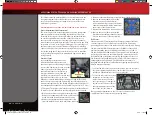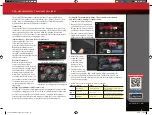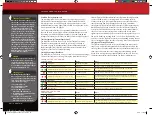
36 • JATO 3.3
ADVANCED TUNING ADJUSTMENTS
This advanced tuning guide will take you one step further into the
innovative adjustment possibilities that have been designed into
Jato. Follow the instructions provided here to unlock Jato’s full
performance potential.
SUSPENSION AND ALIGNMENT SETTINGS
Caster Adjustment (Front Suspension)
The caster angle of the front suspension may be used to adjust the
understeer (push)/oversteer handling characteristics of the Jato.
Generally, increasing the caster angle will move the truck towards
an oversteer condition (more traction on the front tires, less on
the rear tires). Decreasing the caster angle will create a tendency
towards understeer (pushing in the turns). From the factory, the front
suspension is set to a caster angle of 30-degrees. The caster angle of
the front suspension can be decreased to 25-degrees by installing
optional 25-degree caster blocks and steering blocks (see your parts
list). When using the 25-degree caster blocks, be sure to install the
corresponding steering blocks to maintain the original zero bump
steer geometry.
Rear Anti-Squat
Jato’s handling characteristics can be
influenced by adjusting the rear anti-
squat. Anti-squat is a fine-tuning tool that
controls how the rear suspension responds
under acceleration. Increasing the anti-
squat will cause the rear suspension to
compress less under acceleration and
provide more rear traction. Too much anti-
squat will cause the vehicle to become
difficult to control while braking or driving on rough surfaces. Anti-
Squat on Jato can be adjusted by replacing the rear suspension pin
mounts (anti-squat blocks). The factory blocks provide 2.25 degrees of
rear anti-squat. Anti-Squat blocks are available separately in 1.5, 3.0, or
3.75 degrees. The degrees are marked on the blocks for identification.
To replace the anti-squat block, the transmission must be removed:
1. Disconnect the brake rod end from the brake cam.
Remove the 3x10mm shoulder screw, and detach the
brake bell crank from the transmission housing.
2. Remove the 3x12mm button head machine screw
from the molded chassis brace behind the radio tray.
3. Disconnect the throttle return spring from the molded chassis brace.
4. Remove the two 4x18mm countersunk
machine screws, the two 3x15mm
countersunk machine screws, and the four
3x8mm countersunk machine screws from
the bottom of the chassis shown.
5. Separate the transmission from chassis plate.
6.
Remove the two 3x15mm countersunk
machine screws that attach the anti-squat
block to the bottom of the transmission.
Roll Center
Jato has provisions for adjusting the roll center geometry of the front
and rear suspension. The roll center of the vehicle can be raised by
mounting the inner ends of the camber links in a lower position. Raising
the roll center will effectively increase the roll stiffness of the vehicle
(similar to installing swaybars). Adding roll resistance to one end of
the vehicle will tend to add traction to the opposite end. For example,
increasing roll resistance in the rear will provide more traction for the
front wheels and potentially more steering. Raising the roll center on
the front and rear equally will increase overall roll resistance without
changing the handling balance. The default factory locations are
designed to make the truck easier and more forgiving to drive and less
likely to traction roll in turns.
•
To adjust the roll center on the front suspension, remove or replace
the spacers (shims) under the inner camber links. Spacers are
available in different thicknesses. See your parts list.
•
To raise the roll center on the rear
suspension, relocate the inner
camber links to one of the two
holes (position 4 or 5 in image) in
the lower row of the rear camber
link attachment, located near the
base of the rear shock tower.
Once you make adjustments to the roll center, you may need to
re-adjust the static camber to suit your tuning needs.
Anti-Squat
Block
1 2 3
4 5
1 2 3
4 5
2 1
1
2
3
3
4
4
5
5
55077-KC2104-R00-Jato-33-Owners.indd 36
6/6/14 11:53 AM









































